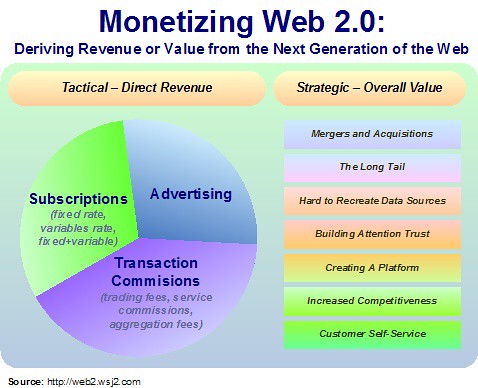
Britizen will be free to use for consumers; and funded by multiple income streams. The initial sources of revenue will be advertising and sponsorship.
Once Britizen is established there is potential to generate income from additional sources. The concept and software can be franchised or licensed to other governments. Anonymised user data can also be sold to carefully chosen partners.
Profits will largely be used to fund benefits for Britizen members; creating a virtuous circle in which more members are encouraged to join and existing members encouraged to stay as benefits increase. This is known as a cross network effect (Shuen, 2008 p.42). The value of an online social network to advertisers and sponsors increases with the number of activate members; generating increased income and profit which can be ploughed back into member benefits.
Part of the Britizen ethos is to support the British economy; all sponsors and advertisers will be British brands. Platform users will be encouraged to support British businesses.
A sample advertisement on a use timeline is shown in Figure 6 of the mockup design.
Early stages
Sponsors and advertisers will provide the initial external revenue sources. The value proposition (Kaplan and Norton, 2000) for these actors will be carefully formulated. Initial sponsors and advertisers need to be attracted to spend their advertising budget on Britizen instead of other social media platforms.
Britizen is a new concept; sponsorship opportunities will initially be focussed on the ‘Innovators’ of Rogers Adoption Model (Rogers, 1983); visionary and imaginative businesses who will produce exciting, attractive materials for the site. The next group of potential sponsors (Rogers ‘early Adopters’) should have strong brands and use innovative techniques to gain a social and economic edge. These businesses (such as Virgin and Innocent) are likely to be willing to form partnerships contributing to the success of the platform. Early sponsors may be offered advantageous rates as inducements to partner with Britizen. The platform needs to generate sufficient income to minimise burn rate (Shuen, 2008, p.24), create a positive cash flow and sustain growth quickly, as HM Government cannot afford to continue providing a subsidy long term. Maximising profit is less important than establishing a strong consumer brand and customer value proposition at this stage; in the short term it is more important to attract large numbers of active users quickly.
The involvement of trend setting sponsors and advertisers will help Britizen appeal to the early user adopters of the platform, and benefit from exposure to these users.
Moving from early stages towards maturity
As the platform expands and matures established high profile businesses such as Vodaphone, Marks and Spencer, and major supermarkets will also be targeted as sponsors. Similar to Rogers ‘Early Majority’; these businesses need solid proof of benefits but are comfortable with innovative ideas. They offer strong customer service and support which appeal to the ‘Early Majority’ consumers the platform will aim to bring on board at this stage. They will be encouraged to extend the user benefits with special offers, discounts and tokens similar to those offered by Tesco Clubcard Rewards and Airline Miles Reward Programs. Such inducements are targeted to the increasingly wide user base.
Maturity
Britizen will continue to generate revenue from sponsors and advertisers as the platform matures and the number of users increases. As the platform develops a track record and large user base revenue will increase; allowing an increased amount to be spent on benefits attracting and retaining users as well as funding increased growth.
Evidence that the platform is successful is also a sound basis to franchise or license the Britizen concept to other governments. These governments may use the platform to encourage similar or different behaviours appropriate to their culture and situation.
Consumer data will be increasingly valuable as both the number of users and quantity of longitudinal data increases. As well as providing a rich source of data for government analysis; there is potential to sell anonymised date to universities and other research organisations. It is important that users build and retain trust in Britizen; such data sales need to be handled sensitively.
References
Kaplan, R.S., Norton, D.P., 2000. Having Trouble with Your Strategy? Then Map It [WWW Document]. Harv. Bus. Rev. URL https://hbr.org/2000/09/having-trouble-with-your-strategy-then-map-it (accessed 4.13.17).
Rogers, E.M., 1983. Diffusion of Innovations, 3rd ed. Collier Macmillan, New York.
Shuen, A., 2008. Web 2.0: A strategy guide. O’Reilly Media Inc., Sevastopol, CA.
